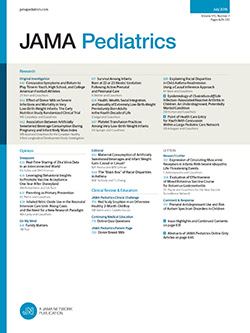Safety Planning Interventions for Suicide Prevention in Children and Adolescents: A Systematic Review and Meta-Analysis.
IF 24.7
1区 医学
Q1 PEDIATRICS
引用次数: 0
Abstract
Importance Suicide ideation and suicide-related behavior (eg, suicide attempts) are increasingly prevalent among adolescents. Evidence supports safety planning interventions for adults at risk for suicide; the effectiveness for adolescents is unknown. Objective To evaluate the effectiveness of safety planning as a standalone intervention for adolescents with suicide ideation and/or suicide-related behavior. Data Sources Ovid MEDLINE, OVID PsycINFO, EBSCO CINAHL, and Scopus (Elsevier) from January 1, 2008, to March 26, 2024. Study Selection Included were all studies that examined safety planning as a standalone treatment for adolescents and assessed suicide ideation, suicide-related behavior including suicide attempts, and/or re-presentations to health care settings. Included were peer-reviewed studies evaluating intervention effectiveness or efficacy, with or without a control condition. Nonempirical studies, gray literature, and studies not available in English were excluded. Data Extraction and Synthesis Two reviewers performed data extraction and quality assessment independently. Meta-analytic random-effects models were used to calculate effect size estimates. Risk of bias was assessed using Joanna Briggs Institute Critical Appraisal tools. Main Outcomes and Measures The outcomes planned for extraction were suicide ideation, suicide-related behavior (eg, attempts; planning with intent to act), and re-presentation to health care settings (ie, emergency department visit; inpatient admission) during the follow-up period. Results Ten studies including 1002 adolescents (mean [SD] age, 15.0 [0.4] years; 76.0% female) met inclusion criteria; 5 were included (n = 619) in the meta-analysis. There was no significant association between safety planning interventions and suicide ideation (Hedges g = 0.11; 95% CI, 0.01-0.21), behavior (Hedges g = -0.09; 95% CI, -0.20 to 0.02), attempts (risk ratio [RR], 1.03; 95% CI, 0.12-8.88) or suicide-related re-presentation (RR, 0.99; 95% CI, 0.29-3.35) at follow-up. Risk of bias for the majority of studies was moderate to high. Conclusions and Relevance This systematic review and meta-analysis found limited research evaluating safety planning with adolescents. Although available data do not support safety planning as a standalone treatment for reducing suicide-related outcomes among children and adolescents, well-powered studies are needed to address this common intervention for suicide prevention in adolescents.儿童和青少年自杀预防的安全计划干预:系统回顾和荟萃分析。
重要性自杀意念和自杀相关行为(如自杀企图)在青少年中越来越普遍。证据支持对有自杀风险的成年人采取安全规划干预措施;对青少年的有效性尚不清楚。目的评价安全规划作为独立干预青少年自杀意念和/或自杀相关行为的有效性。数据来源:2008年1月1日至2024年3月26日,OVID MEDLINE, OVID PsycINFO, EBSCO CINAHL和Scopus (Elsevier)。研究选择纳入了所有将安全计划作为青少年独立治疗的研究,并评估了自杀意念、自杀相关行为(包括自杀企图)和/或再向卫生保健机构就诊的研究。包括同行评议的研究,评估干预的有效性或疗效,有或没有对照条件。非实证研究、灰色文献和没有英文版本的研究被排除在外。数据提取和综合两名审稿人独立进行数据提取和质量评估。meta分析随机效应模型用于计算效应大小估计值。使用乔安娜布里格斯研究所关键评估工具评估偏倚风险。提取的主要结局为自杀意念、自杀相关行为(如自杀未遂;有计划地采取行动),并向卫生保健机构重新介绍(即急诊室访问;住院病人入院)。结果10项研究纳入1002名青少年(平均[SD]年龄15.0[0.4]岁;76.0%女性)符合纳入标准;5例纳入meta分析(n = 619)。安全规划干预与自杀意念之间无显著关联(对冲系数g = 0.11;95% CI, 0.01-0.21),行为(对冲系数g = -0.09;95% CI, -0.20 ~ 0.02),尝试(风险比[RR], 1.03;95% CI, 0.12-8.88)或与自杀相关的再表现(RR, 0.99;95% CI, 0.29-3.35)。大多数研究的偏倚风险为中等至高。结论和相关性本系统综述和荟萃分析发现评价青少年安全计划的研究有限。虽然现有数据不支持安全计划作为减少儿童和青少年自杀相关结果的独立治疗,但需要有充分证据的研究来解决这一预防青少年自杀的常见干预措施。
本文章由计算机程序翻译,如有差异,请以英文原文为准。
求助全文
约1分钟内获得全文
求助全文
来源期刊

JAMA Pediatrics
PEDIATRICS-
CiteScore
31.60
自引率
1.90%
发文量
357
期刊介绍:
JAMA Pediatrics, the oldest continuously published pediatric journal in the US since 1911, is an international peer-reviewed publication and a part of the JAMA Network. Published weekly online and in 12 issues annually, it garners over 8.4 million article views and downloads yearly. All research articles become freely accessible online after 12 months without any author fees, and through the WHO's HINARI program, the online version is accessible to institutions in developing countries.
With a focus on advancing the health of infants, children, and adolescents, JAMA Pediatrics serves as a platform for discussing crucial issues and policies in child and adolescent health care. Leveraging the latest technology, it ensures timely access to information for its readers worldwide.
 求助内容:
求助内容: 应助结果提醒方式:
应助结果提醒方式:


